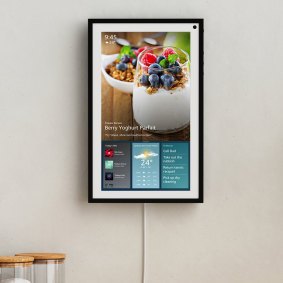
Before we replace smartphones entirely, we can expect to see devices that put some of their components in more natural positions on our body. Just like we put activity detection technology on our wrists and speakers on our ears, more devices in the near future will put cameras on our faces.
Meta and Ray-Ban’s smart glasses are an early example of this, with the $450 specs connecting to your phone but letting you leave it in your pocket when you want to use the camera. They also have microphones, and speakers in the arms, so they can stand in for earpods, cameras and either sunglasses or prescription glasses.

The Ray-Ban and Meta Smart Glasses work with tinted or prescription lenses.
As with the AI Pin, there’s an element in the marketing of keeping you “in the moment”, meaning giving you the ability to capture images without putting a phone between you and the thing you’re preserving a memory of. But in this case, you still have your phone in your pocket as an option too. The glasses can be used to take still images or video, with a flashing white light that (hopefully) indicates to those around you that the camera is in use.
But that’s only part of what we use cameras on our phones for. Increasingly we use them to scan codes, send images of things to friends and family, search the internet for information about objects we see, or even get directions and advice related to where we are. Smart glasses with cameras will absolutely enable this without the need to dig out our phone, and Meta is already moving in that direction. It’s currently testing a software update for the glasses that gives it AI agent access to the camera and microphones, so you can ask about what you see and hear.
Phone-free household notifications
More than a year ago, Google showed off a design study it had undertaken that explored ways household objects could keep you up to date with important information without encouraging you to be glued to your phone. In a future where any small device can be connected to the internet it’s certainly possible, though the example solutions were perhaps a little impractical.
There was a little tapping arm that could make noise near an object (like a pill jar) to alert you to regular tasks instead of having a noisy alarm on your phone, an air-blowing machine to rustle leaves on one of your plants to let you know you had new messages, and even a mushroom-shaped doodad that casts different shadows to offer notifications.

Information could gradually move from your phone to devices around your home.
Google described these experiments as thought-starters, and thus far they haven’t led to real products in any meaningful way, but they do highlight some opportunities and challenges in transitioning away from screens entirely. People actively engaged in work or certain other activities will likely need screens for a very long time, and trying to replace them doesn’t make much sense. The trick is making sure they can turn off afterwards to enjoy non-screen activities without their phone pulling them back in. And in the near term the best solution to that may be different screens.
Smartwatches are great about letting you know what’s happening without compelling you to open any apps or drop what you’re doing, though they also need to be carefully configured so they’re not just nagging you about everything that’s happening on your phone. But ambient displays might offer an even better solution, displaying information like the weather forecast, calendar events and messages you can glance at as you pass. Google and Amazon both already make these, and they work as voice assistant speakers and little TVs as well as smart displays. They’re not yet great at letting you know when you may have missed something important, but recent advancements in AI means sooner than later they’ll be crunching your phone’s data and catching you up when you need it. Elsewhere, various companies are working on small and less general connected screens, from tickers that show the latest update from specific contacts to unobtrusive wooden panels that can light up alerts.
Get news and reviews on technology, gadgets and gaming in our Technology newsletter every Friday. Sign up here.









 Add Category
Add Category